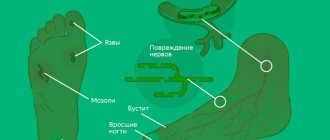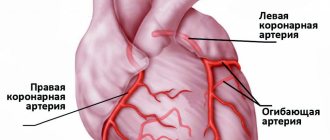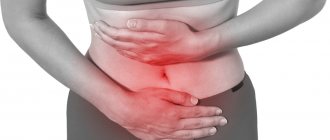General information about myocardial infarction
Myocardial infarction
ー this is the death of a section of the heart muscle, which occurs due to a lack of blood supply. As a rule, a heart attack does not develop suddenly; it is preceded by coronary heart disease or other pathology of the organ that leads to disruption of blood flow to the myocardium. Under conditions of oxygen and energy starvation, cells die. At the initial stage, this process is reversible; if blood flow is restored, the area of death can be limited and severe heart failure can be prevented.
General information
As statistical studies show, myocardial infarction most often develops in men aged 40 to 60 years. In women, this disease occurs approximately one and a half to two times less often.
Myocardial infarction occurs in patients with coronary heart disease (CHD), atherosclerosis, and arterial hypertension. Risk factors for the development of myocardial infarction include smoking (as it causes a narrowing of the coronary vessels of the heart and reduces the blood supply to the heart muscle), obesity, and lack of physical activity.
At the same time, myocardial infarction may be the first manifestation of IHD.
Unfortunately, myocardial infarction is now one of the main causes of disability in adulthood, and the mortality rate among all patients is 10-12%.
Classification of myocardial infarction
Depending on which part of the heart wall is damaged, the following types of heart attacks are distinguished:
- intramural ー the dying zone is located deep in the myocardium;
- transmural - affects the entire thickness of the wall;
- subendocardial - the lesion is located near the inner lining of the heart;
- subepicardial - near the outer sac of the heart.
According to the nature of the flow, they are distinguished:
- acute infarction (primary);
- recurrent, develops within 2 months after acute;
- repeated, develops later than 2 months after the first heart attack.
According to the nature of the symptoms:
- typical form, characterized by chest pain radiating to the left arm and left half of the body;
- atypical forms (abdominal ー abdominal pain, asthmatic ー accompanied by severe shortness of breath, cerebral ー with dizziness, confusion, edematous, peripheral ー pain in the arm, face, neck, painless, combined).
The main signs of a heart attack in women and men
1. Chest discomfort - most heart attacks are accompanied by a feeling of discomfort in the central part of the chest that does not go away within a few minutes (pressure, squeezing or pain). 2. Discomfort in other areas of the upper body - pain or discomfort in one or both arms, back, neck, jaw or stomach. 3. Difficulty breathing (whether accompanied by a feeling of discomfort or not). 4. Cold sweat, nausea or dizziness.
The main sign of a heart attack in both men and women is pain or discomfort in the chest. However, women are more likely than men to experience other signs of a heart attack: difficulty breathing, nausea/vomiting, and back or jaw pain.
Mechanism of development and causes of myocardial infarction
The lion's share of heart attacks develops against the background of atherosclerotic damage to the coronary vessels and aorta (formation of cholesterol plaques in the wall of blood vessels). Other possible causes of circulatory disorders in the heart muscle are vasospasm and thrombosis. All this leads to the fact that the cells do not receive the required amount of oxygen and die.
The main causes of myocardial infarction:
- coronary heart disease, atherosclerosis;
- sudden physical activity or stress during ischemic heart disease;
- thrombosis of the coronary arteries.
FAQ
Why is angina pectoris dangerous?
If the patient neglects his health and refuses medical care, the frequency of attacks may increase and the pain may intensify. A further decrease in the lumen can cause acute oxygen starvation and the development of myocardial infarction with a poor prognosis.
How to relieve an angina attack at home?
When the first sensations of pain appear, you should immediately stop working or moving, take a sitting or lying position, put a nitroglycerin tablet under your tongue, which should always be at hand. If your eyes darken and perception deteriorates, you should ask others for help. It is important to try to record the condition preceding the attack and the duration of the last one in order to report it to the attending physician.
How to determine angina?
Among the characteristic signs of angina pectoris are severe pressing pain in the heart area with a return to the peripheral parts of the body, noticeable fluctuations in pulse and pressure. The attack occurs with sudden physical or psycho-emotional stress and subsides within 15-20 minutes. Only the attending physician can carry out differentiated diagnostics and accurately name the cause of the disease.
Myocardial infarction in children
It is believed that this pathology only affects older people, but this is not so. A heart attack can also occur in a child in the following cases:
- inflammation of the coronary arteries in infectious diseases, rheumatoid arthritis, lupus and other autoimmune pathologies;
- infectious and rheumatic endocarditis (after a sore throat, for example);
- abnormalities in the structure of heart vessels;
- heart injuries;
- pheochromocytoma - a tumor that constantly produces adrenaline;
- congenital heart defects;
- heart tumors.
Reasons for development
The key cause of the disease, which is called myocardial infarction, is considered to be the formation of a blood clot. Typically, a blood clot forms inside a coronary artery that is already narrowed due to atherosclerosis, a condition in which fatty deposits (or atherosclerotic plaques) accumulate along the inner walls of blood vessels.
Throughout life, fat, calcium, proteins and inflammatory cells accumulate in the arteries, forming atherosclerotic plaques. These deposits are hard on the outside but soft and crumbly on the inside. When the plaque hardens, the outer shell cracks. This is called plaque rupture. Platelets (plates in the blood that help it clot) become trapped in the area, and blood clots form around the plaque. If a blood clot blocks an artery, the heart muscle is starved of oxygen. The muscle cells soon die, causing permanent damage. This is the most common reason, but not the only one.
Slowing of blood flow in the coronary artery can occur when the heart beats very quickly or a person has low blood pressure. If oxygen demand exceeds supply, a heart attack can occur without a blood clot forming. People with atherosclerosis also often suffer from this type of heart attack. Source: Myocardial infarction. Zhmurov D.V., Parfenteva M.A., Semenova Yu.V. Colloquium-journal, 2021. p. 56-61.
In rare cases, coronary artery spasm can also cause a heart attack. During this coronary spasm, your arteries narrow or spasm, cutting off the blood supply to the heart muscle (ischemia). This can happen at rest or under stress, even if the person does not have serious coronary heart disease.
If vascular patency is not restored, there is a risk that recurrent myocardial infarction will develop over time. It will cause even more damage to the heart.
Risk factors for myocardial infarction
The following factors lead to the development of atherosclerosis, ischemic heart disease and, as a consequence, heart attack:
- high blood cholesterol (due to poor diet or metabolic diseases);
- obesity;
- hypertonic disease;
- smoking;
- sedentary lifestyle;
- diabetes.
Symptoms of myocardial infarction
Myocardial cells do not die immediately, since hypoxia develops gradually; they “suffer” for 1-2 hours before final death. At this time, they can still be saved, so timely seeking help determines the further outcome.
Pre-infarction state
Warning signs of a heart attack may appear several hours or even days before the attack. By seeking medical help during this period, you can prevent a disaster.
Possible signs of an impending heart attack:
- the appearance of chest pain during physical activity, emotional stress;
- sensations of interruptions in heart function, dizziness, increased heart rate;
- increased frequency of angina attacks;
- Chest pain is not relieved by nitroglycerin tablets.
Important!
Among all registered myocardial infarctions, about 20% are fatal within the first hour of the attack. It is not the doctors or “neglected medicine” that are to blame for this; death occurs even before seeking help due to the fact that the patient himself and those around him cannot recognize the attack and hesitate to call an ambulance. Therefore, if your loved ones have an increased risk of developing a heart attack, study the symptoms and algorithm of actions in case of a heart attack.
Symptoms of acute myocardial infarction
Myocardial infarction is manifested by pain. The pain is localized in the chest, radiating to the left arm, shoulder, half of the face, and side. The nature of the pain is pressing, burning. During an attack, a person feels a lack of air, fear of death, cold sticky sweat appears, and the skin turns pale.
A distinctive feature of a heart attack from angina pectoris: with the first, the pain does not subside at rest or after taking nitroglycerin, lasting more than 20 minutes.
3.Bypass surgery
If for some reason angioplasty cannot be done, emergency coronary artery bypass grafting
. Sometimes bypass surgery is preferred because of the specific location of the artery blockage or multiple blockages.
After a heart attack
the patient needs to stay in the hospital for at least a few more days. All this time, doctors will closely monitor your health. Checking your pulse, heart rhythms, blood pressure, and your body's response to medications will help ensure that your heart attack is not serious.
Your doctor will likely recommend that you take medications that reduce the risk of another heart attack or complications. Ultimately, they will help maintain health and prolong life after a heart attack. These medications may include angiotensin-converting enzymes, aspirin, antiplatelet medications, beta blockers, and statins.
These medications will need to be taken over time. And perhaps throughout life. You should not violate the dosage regimen recommended by your doctor or decide to stop treatment on your own, even if you feel well. All this increases the likelihood of recurrent myocardial infarction.
About our clinic Chistye Prudy metro station Medintercom page!
Diagnosis of myocardial infarction
After hospitalization, the patient undergoes the following diagnostic measures:
- ECG;
- clinical and biochemical blood test;
- blood test for creatine phosphokinase (CPK), lactate dehydrogenase (LDH), troponin;
- EchoCG (ultrasound of the heart);
- coronary angiography.
These methods help confirm the diagnosis of a heart attack, clarify the location of the necrosis focus, and determine treatment tactics.
Forecast and prevention of heart attack
The greatest mortality from myocardial infarction is observed in the first day; therefore, if medical care was provided in a timely manner, the chances of recovery increase significantly. The overall prognosis depends on the area of damage to the heart muscle.
For prevention, you must follow these principles:
- quitting smoking and alcohol;
- proper, balanced nutrition;
- regular physical activity (check with your doctor);
- regular preventive visits to a cardiologist in the presence of diseases of the cardiovascular system.
Life after a heart attack
Currently, coronary insufficiency and myocardial infarction are one of the main causes of death and disability among the population of most industrialized countries. According to WHO experts, mortality from cardiovascular diseases will steadily increase in the coming decades. In Belarus, the situation with cardiovascular diseases in general and myocardial infarction in particular is also alarming.
More than 4,000 cases of this disease are registered annually in Minsk alone, of which up to 25% are people of working age. According to the City Cardiology Center, 90% of patients of working age, as a rule, return to work, of which 35% are fully employed and in their previous profession.
This means that a heart attack in itself is not a death sentence, and life continues after it, but it makes adjustments to the patient’s thinking, his lifestyle, his attitude towards himself and others.
WHAT IS A MYOCARDIAL INFARCTION?
WHAT PSYCHOLOGICAL PROBLEMS DO THE PATIENT ARISE?
AND HOW TO OVERCOME THEM
Myocardial infarction is the acute and most severe form of coronary heart disease, in which a section of the heart muscle dies as a result of blockage of the coronary artery that supplies it with blood.
Myocardial infarction itself is a severe stress for the patient. He is instilled with constant fear of a possible recurrence of a heart attack.
The patient is constantly harassed by:
Internal tension— concern for the outcome of the disease, for the well-being of the family, for work, for the future prognosis. In this case, you need to contact a psychotherapist or a psychologist , who will help you calm down and calm your worried relatives.
Fear of developing a recurrent myocardial infarction and sudden death “from a heart attack.” Anxiety increases with physical stress, leaving the house, or moving away from a place where medical care can be provided. Such patients should walk gradually, increasing their mileage daily, go out with an escort in the first days, and have nitroglycerin with them.
Unjustified concern for your health . Patients often and without reason count their pulse, measure their blood pressure, and visit various specialists. In such a situation, you need to talk with your doctor, psychologist, psychotherapist, and switch your attention to other events in life in order to divert attention from unreasonable fears.
Psychasthenia syndrome - a person is overcome by general weakness, a feeling of constant fatigue, irritability, sleep disturbance, decreased performance . There may be a depressed mood, apathy, a feeling of hopelessness, tearfulness - depression syndrome . In these cases, it is necessary to consult a psychotherapist. The patient must be explained that a heart attack is not a death sentence.
Not often, but there are also cases of “disease denial,” when the patient refuses to believe that he has a serious illness and ignores the doctor’s recommendations. It should be remembered that for a patient who has suffered a myocardial infarction, both overestimation of the severity of his condition and its underestimation are equally dangerous.
METHODS OF REHABILITATION OF THE PATIENT
Currently available methods of rehabilitation (restorative treatment) of patients after myocardial infarction can be combined into two groups: non-pharmacological and medicinal.
Non-drug treatment methods involve, first of all, changes in lifestyle and lifestyle. This includes:
To give up smoking. Quitting smoking for two years reduces the risk of coronary death by 36%.
Normalization of body weight. To assess the correspondence between weight and height, the body mass index is used. In order to calculate your body mass index (BMI), you need to divide your weight in kilograms by your height in meters, squared, according to the formula:
BMI= weight (kg)/height (m²)
Normal index values are 20-25 kg/m². An increase in the index to 25-30 kg/m² indicates the presence of excess body weight, more than 30 kg/m² - obesity.
Changing the nature of nutrition. The main goal of the diet is to reduce cholesterol and other atherogenic blood lipids while maintaining the physiological completeness of the diet.
It is necessary to give preference to a diet low in saturated fat and cholesterol, with sufficient amounts of vegetables, fruits, and grain products that will provide the body with essential vitamins, minerals, fiber (fiber) and complex carbohydrates. This includes :
Regular consumption of a variety of vegetables and fruits - at least 400 g.
Moderate consumption of dairy products - (0.5-1% fat content) milk, low (20%) fat cheeses, low-fat cottage cheese, yogurts, buttermilk.
Give preference to fish , including fatty fish (cod, haddock, flounder, herring, sardine, tuna, salmon). Fish should be present in the diet at least 2-3 times a week.
From meat products, choose meat without streaks of fat: turkey, chicken, veal, game, rabbit, young lamb.
Consume no more than 2-3 eggs per week . Limit your consumption of yolks.
Recommended drinks : tea, black coffee, water, sugar-free soft drinks.
Consume sugar only in moderation, table salt - less than 5 grams per day.
Limit (it is better to completely refuse) the consumption of alcoholic beverages - less than 30 grams of pure alcohol for men and 20 grams for women per day.
A balanced diet should be combined with systematic physical training . Under the influence of moderate-intensity physical training, there was a reduction in overall mortality by 23% and sudden death by 37% in patients who had previously suffered a myocardial infarction.
Physical activity also includes household activities : housekeeping, seasonal work in the garden or vegetable garden, walking up the stairs instead of using the elevator, walking to work and home, etc.
Before starting physical activity, you should talk to your doctor! We must always remember that along with the positive effect, inadequate physical activity can lead to the development of severe complications during the course of the disease .
It is impossible to give a single recommendation for all patients regarding the timing of the resumption of sexual activity . In the vast majority of cases, this is one to one and a half months from the date of the heart attack. But it is better to consult your doctor on this issue.
Know and control blood pressure. In a person who has had a myocardial infarction, it should be 120/80 mm. rt. Art.
Drug treatment of coronary heart disease and myocardial infarction includes:
The first and basic rule is to constantly take medications. “And the best medicine will not help the patient if he refuses to take it.” Cervantes (1547 - 1616).
The second rule is the rule of combination therapy.
Patients who have suffered a myocardial infarction are simultaneously prescribed several drugs with different mechanisms of action. At a minimum, they must take five medications, four of which (except the second - for life):
Acetylsalicylic acid helps reduce the formation of blood clots in the heart and blood vessels and is the basis for the prevention of arterial thrombosis. Regular use of acetylsalicylic acid reduces the risk of recurrent myocardial infarction by an average of 23%.
Clopidogrel - has an antiplatelet effect, like aspirin, and requires mandatory use for at least 12 months after myocardial infarction.
Statins are drugs that lower blood cholesterol levels, are safe for long-term use, are well tolerated by most patients, and reduce the risk of atherosclerotic cardiovascular complications.
Beta blockers interrupt the signals that the body sends to the heart during exercise and emotional stress, reduce the risk of sudden death, recurrent myocardial infarction, and increase the life expectancy of patients who have had a myocardial infarction
ACE inhibitors are drugs that prevent the development of heart failure, increase the duration and improve the quality of life of patients who have suffered a myocardial infarction.
RECOMMENDATIONS FOR PATIENTS IN EVERYDAY LIFE
Changing your lifestyle means changing your previously established rules and habits.
Start your morning so that you have time to have a quiet breakfast and take your medications. Some medications (such as nitrates) should be taken 20-30 minutes before leaving home.
Leave the house early so that you can stand at the entrance for a few minutes, especially in the cold season.
Get rid of the habit of starting walking at a fast pace. Give your heart time to get used to, adapt to the given rhythm.
Give up the habit of rushing, running after departing transport as if it were the last bus (trolleybus) in your life.
Wherever you are (at home, at work, visiting, in the forest, at the dacha, etc.), you must have nitroglycerin (tablets, capsules, spray) with you.
If you leave home for any period, even for a short period of time, you need to have the necessary supply of the medications you take with you in order to feel safe and not create unnecessary problems for others.
It is advisable that in your purse (purse, car glove compartment, etc.) there is the latest electrocardiogram that you had at your doctor’s appointment. No one knows where you may need medical help, and then the old “film” will do a good service to your heart.
Remember! The most important rule for successful treatment and recovery after a heart attack is cooperation between the doctor and the patient.
Know! By following the recommendations outlined, you can live a long and quality life after a heart attack!
Author: Evtukh O.V. – head of outpatient
outpatient department of the GCC
Editor: Arsky Yu.M.
Computer layout and design: Zgirskaya I.A.
Responsible for the release: Tarashkevich I.I.
Health Committee of the Minsk City Executive Committee
Healthcare Institution “2nd City Clinical Hospital”
City Health Center
Minsk-2012
Diagnosis and treatment of myocardial infarction and pre-infarction condition in Medical
When should you see a doctor?
A person needs to consult a cardiologist if symptoms of a cardiovascular system pathology appear (chest pain, dizziness, cough, shortness of breath, bluish skin, etc.). You should not self-medicate. Numerous methods of traditional medicine are permissible for use only after the doctor’s permission and after treatment of the acute period of the disease.
Drug treatment of myocardial infarction and pre-infarction condition
Patients in a pre-infarction state are prescribed drugs that improve blood supply to the heart muscle, anti-atherosclerotic agents, and vitamin-mineral complexes.
In the acute period of a heart attack, analgesics, anticoagulants (prevent blood clotting) and thrombolytics (dissolve an already formed blood clot) are indicated.
Surgery
It is possible to more effectively restore blood supply to the myocardium through surgical intervention, which must be carried out in the first hours of a heart attack, then the chances of successful healing are greatest.
Coronary artery bypass grafting
The method of operation is to create a bypass route for blood supply to the affected area of the myocardium. The aorta and coronary vessel beyond the blockage are connected using a section of vein taken from the patient's lower leg.
Coronary artery angioplasty
Narrowing of the artery can be relieved by inserting an instrument that widens the artery through the femoral vein. Next, a stent is installed, which fixes the shape of the vessel, preventing its narrowing and restoring blood flow.







